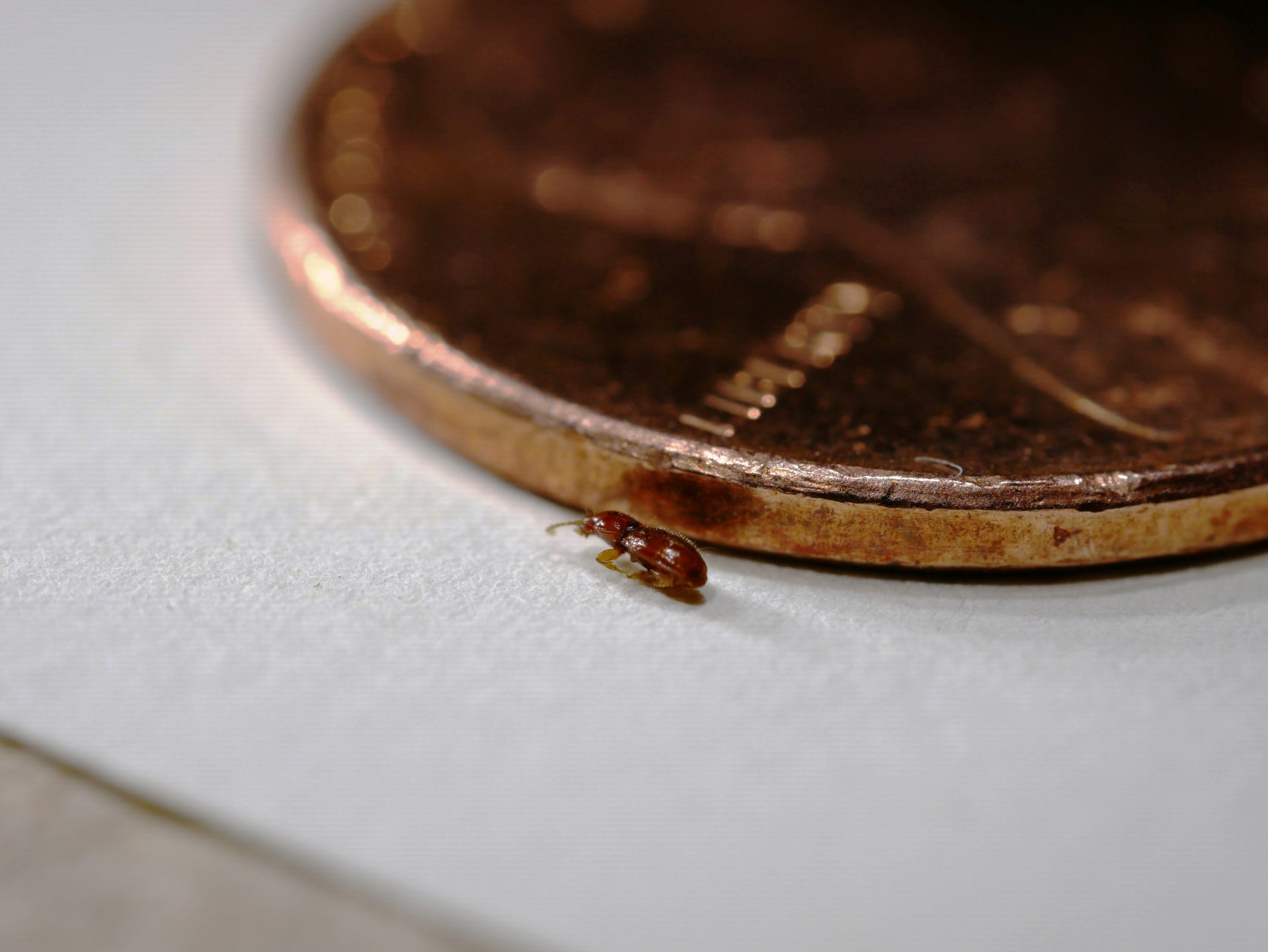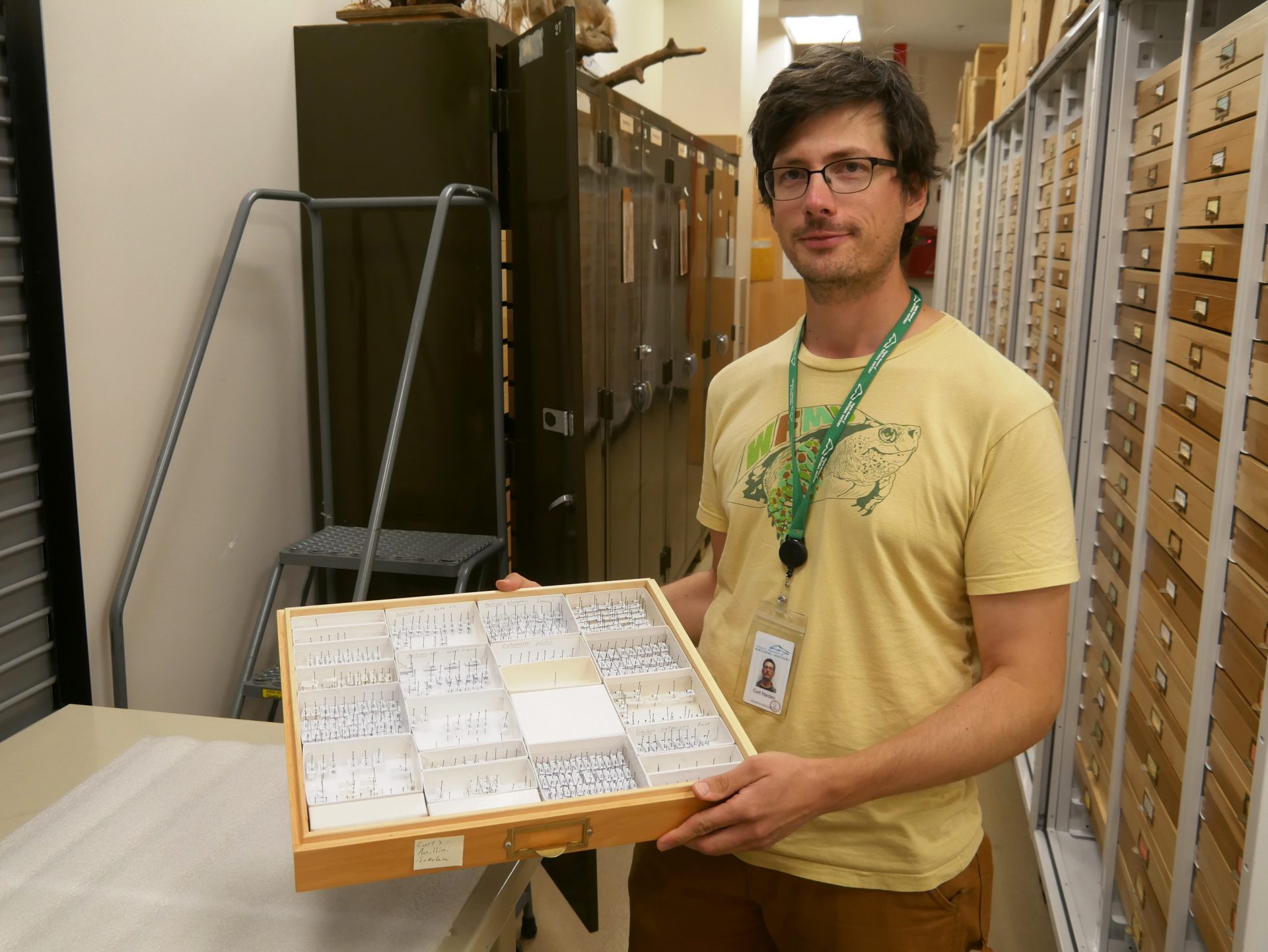 By BEN R. WILLIAMS
By BEN R. WILLIAMS
The minivan roared up the mountain in the driving rain, spumes of red mud flying from the tires. The vehicle seemed to be heading straight toward the lightning flashing continually above Pearisburg, Va., crawling higher and higher along a washed-out gravel road.
There were four occupants chuckling nervously inside the vehicle, all Virginia Museum of Natural History (VMNH) staff members: Executive Director Dr. Joe Keiper, Assistant Curator of Invertebrate Zoology Dr. Kal Ivanov, Science Administrator Ben Williams and Research Associate Curt Harden.
At the top of the mountain, Harden knew, was a spot where a gravel service road crossed the Appalachian Trail. And at that spot, he hoped, was a very small, very uncommon, and very blind beetle.
That beetle – Serranillus septentrionis – had been the Moby Dick to his Captain Ahab for the better part of three years.
A serious collection
Harden, 30, is a graduate of George Washington High School in Danville and received his Bachelor’s degree from Virginia Commonwealth University. From April through July of 2019, he spent his time sorting VMNH’s collection of butterflies and moths before leaving to attend graduate school at South Carolina’s Clemson University.
Entomology – the study of insects – is Harden’s passion, particularly the family Carabidae, also known as ground beetles. There are more than 40,000 different species of carabids worldwide, but much of Harden’s interest lies with the smallest members of the family in our region: The genera Anillinus and Serranillus.
In Virginia, about six species from these two genera can be found. They are not big and flashy like a rhinoceros beetle or a ladybug; they are tiny, smaller than a pinhead, and usually pale or dark brown. It takes a well-trained eye and a powerful microscope to tell the difference between the species.
Harden said that he first became fascinated with the carabid family while working under a Ph.D student at Indiana’s Purdue University. The student was studying ground beetles, and Harden’s job was to check a couple hundred pitfall traps per day and sort thousands upon thousands of carabids.
“It was sort of a crash course in identifying them, and I enjoyed it a lot,” Harden said. “After that, I got a job doing a similar thing, pitfall trapping for carabids in Front Royal for NEON, the National Ecological Observatory Network. The first year doing that job is when it all kind of clicked. I realized that I really enjoyed working with them and identifying them.”
In 2015, Harden became serious about collecting the smallest members of the carabid family after realizing there were serious gaps in our understanding of these microscopic creatures. While many people collect large, flashy insects, fewer are interested in collecting something that is about the size of the period at the end of this sentence.
It had never before occurred to Harden, he said, that he might be able to go out and collect beetles right here in Virginia that were unknown to science, creatures that no humans had ever laid eyes on before.
At first, he said, it was a frustrating experience collecting these miniscule beetles, since few people have ever recorded data about them. When asked how many people in America study these beetles, Harden named three – he’s corresponded with all of them.
However, he said, that lack of information provided a sense of purpose, and for four years he has worked to collect and identify the tiniest ground beetles of Virginia.
For much of that time, however, there was one species that continued to elude him.
 The White Whale
The White Whale
According to Harden’s research, only seven specimens of Serranillus septentrionis had ever been collected. All seven specimens has been collected in one of two locations: Black Horse Gap on the Blue Ridge Parkway and a lonely mountain road just outside Pearisburg.
These tiny beetles lack eyes and are completely blind. They don’t have flight wings, either. They spend their lives in leaf litter and underneath rocks. They probably prey on anything small and soft that happens to wander into their path, but no one really knows, according to Harden; they have barely been collected, much less studied in the wild or raised in captivity.
“It’s the only member of the genus known in Virginia and I had never collected that genus,” he said. “It’s in this tribe that I’m studying and I wanted specimens of it. I was really eager to see it. I thought it was cool too that it’s only known from Virginia. There aren’t that many carabids that are only known from Virginia.”
“It got to be a white whale type of thing,” Harden continued. “I went to Black Horse Gap for the first time and thought I’d just sift some leaf litter, grab a few and be on my way. But I spent all day there and didn’t find a single thing. … I didn’t get anything. It was really frustrating.”
After the third fruitless trip to Black Horse Gap, Harden said, the elusiveness of Serranillus septentrionis began to bug him (no pun intended).
While visiting the Smithsonian’s entomology department, Harden saw a sign on a door and recognized the name of the man who had collected Serranillus at Black Horse Gap.
“I walked in and introduced myself,” he said. “After that was out of the way, I said, ‘OK, where did you find Serranillus septentrionis?’ He remembered the exact rock face. … There’s a prominent boulder, and he said it was at the base of that. … He stopped there, spent about half an hour, picked it up and went on his way. But even after that, every time I went there, I focused on that spot and never found one.”
The only other place the beetle had ever been collected was on the top of the mountain near Pearisburg, but Harden had never visited the site simply because he was concerned his car wouldn’t make it up the gravel roads.
However, when Harden and other museum staff made a trip to Mountain Lake in July of 2019 to collect insects, Harden realized that the magic spot near Pearisburg was just a short jaunt up the road.
As the museum minivan got closer to the mountain, however, a previously beautiful day began to turn dark.
“I have three innocent people going with me there just because I want to get this beetle,” Harden said, laughing. “As we get nearer, it gets darker and raindrops start pattering down. I think it was probably around the time the pavement ended that it really started just pouring.”
Once at the top of the mountain, Harden used his GPS to find the area where Serranillus had been collected in the past. However, he said, he did not feel his prospects were good. While the rain had finally stopped, everything was soaking wet. A small wildfire had recently burned much of the area. Nonetheless, he began his hunt.
For about an hour, Harden poked through leaf litter and looked under rocks, trying to spot a beetle less than half the size of an uncooked grain of rice. Near the end of that hour, he was in the middle of a jumble of large rocks, slick with wet leaves.
“I remember I reached down in a crevice between some boulders and sifted some litter, and there was a little blind carabid running around,” he said.
Harden tempered his excitement; on a previous occasion, he had been convinced he’d found a Serranillus, only to get it home under a microscope and discover it was a more common species.
“When I got home (that night), my girlfriend had just arrived, and she and my mom and I were going to go out to dinner,” he said. “I was covered in slime and had to change. But I said, ‘One minute, I’ve got to check something.’”
A closer inspection confirmed it: He had found the eighth Serranillus septentrionis ever collected.
More fish in the sea
There are more white whales out there to be collected, Harden said; his next target is Catapocerus hamiltoni, another small blind beetle from a different family. The beetle is known only from female specimens, all of which were collected near Pittsburgh in the late 1800s and early 1900s. Harden hopes to travel to Pennsylvania and find the first male specimen so he can compare it to other similar male Catapocerus beetles he has collected in Virginia, at least one of which is likely a species currently unknown to science.
While in graduate school at Clemson, Harden plans to continue his studies into these small, mysterious beetles. All of the work is for a purpose, he said; by collecting these specimens, he is expanding our understanding of the distribution of these unique species which have largely been ignored.
There is, of course, another reason these ground beetles are worth investigating, Harden said:
“It’s fun.”



